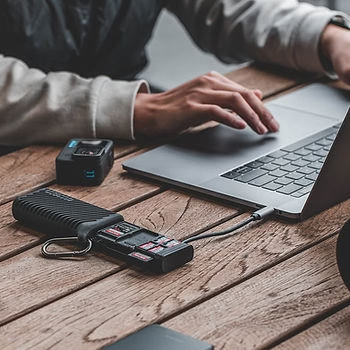When it comes to selecting a memory card for a smartphone, digital camera, drone or portable games console, it’s essential to know the differences between SDHC, SDXC and MicroSD. These technical designations may seem complex, but they actually refer to precise capacity and physical format standards. In this article, we’ll explore in detail the characteristics of each type of memory card, so you can choose the one that best suits your technological needs and everyday use.

1. What is a MicroSD card?
The MicroSD card (for micro Secure Digital) is an ultra-compact memory card format. It is widely used in portable electronic devices such as smartphones, tablets, drones, action cameras (like GoPro), game consoles and GPS units. This small format (15x11x1 mm) is appreciated for its discretion and practicality. There are three main variants, differentiated by their storage capacity: MicroSD, MicroSDHC and MicroSDXC.
Good to know: Standard-size SD cards (often used in DSLRs, professional cameras and some laptops) are larger than MicroSD, but work on similar principles.

2. SDHC: Secure Digital High Capacity
- Capacity: from 4 GB to 32 GB
- File system: FAT32 (standard used to ensure compatibility with most systems)
- Compatibility: SDHC and SDXC compatible devices
- Typical applications: Taking photos, recording HD video (720p/1080p), storing music and documents on smartphones or compact cameras
SDHC cards are particularly suited to occasional users who don’t handle large files. They are economical and more than sufficient for basic use. However, their maximum capacity of 32 GB can quickly become insufficient if you store a lot of videos or applications.

3. SDXC: Secure Digital eXtended Capacity
- Capacity: from 64 GB to 2 TB
- File system: exFAT (optimized for storing files larger than 4 GB)
- Compatibility: Only with SDXC-compatible devices
- Common uses: 4K or 8K video, RAW photography, heavy video games, massive storage on sports cameras or professional drones.
SDXC cards offer a far more powerful storage solution than SDHC. In addition to their very high capacity, they generally benefit from higher write and read speeds, which is crucial for videographers or professional photographers. They are also designed to withstand intensive workloads.
👉 Discover a great option here : SAMSUNG PRO Plus microSDXC 256 GB – Up to 180 MB/s
4. MicroSD: one format, several standards
The term MicroSD refers only to the physical size of the memory card. Within this same envelope, you can find different capacity standards:
- MicroSD (up to 2 GB): now obsolete, rarely used
- MicroSDHC (4 GB to 32 GB): still common in basic devices
- MicroSDXC (64 GB to 2 TB): the current standard for demanding devices
So it’s essential to check not only the format, but also the capacity standard and compatibility of your device. Some cameras or older phones may not support SDXC cards.

5. How to choose the right memory card?
To make the right choice, it is useful to consider several factors:
- Your device’s compatibility: Read your device’s specifications (manual or datasheet) to find out whether it accepts SDXC cards.
- Desired storage capacity: If you’re recording high-resolution video, it’s best to aim for more than 64 GB.
- Read/write speed: look for UHS (Ultra High Speed), speed classes (U1, U3, V30, V60, V90) to ensure smooth performance, especially for video.
- Operating environment: Some cards are designed to withstand water, heat, X-rays or shock, which is useful for adventurers or field photographers.
- Budget: SDHC cards are the least expensive, but have limited capacity. SDXC cards cost more, but offer far superior performance.
Conclusion
To conclude, understanding the differences between SDHC, SDXC and MicroSD will help you avoid compatibility errors and choose a memory card perfectly suited to your needs. Remember that MicroSD refers to the physical size of the card, while SDHC and SDXC define the capacity and file system. If you’re looking to store just a few photos or HD videos, a MicroSDHC card will do the trick. On the other hand, for more demanding needs such as 4K video, professional photography or gaming, a MicroSDXC card is essential.
Always check the compatibility of your device before buying, and give preference to well-known brands to avoid unpleasant surprises. A good choice of memory card not only improves the performance of your devices, but also guarantees the security of your most precious data.





Leave a Reply